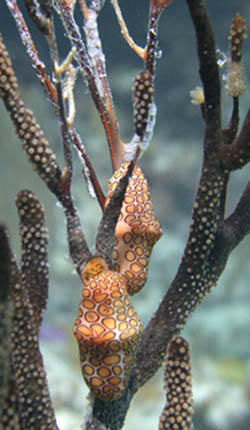



A major goal of community ecology is to understand how interactions among resident organisms affect their distribution and abundance. In marine communities, predation clearly plays a pivotal role in affecting the phenotype of organisms as well as community organization. The intensity of consumer pressure on coral reefs exerts strong selection on prey to avoid being eaten. Prey species unable to physically escape or tolerate consumers may produce noxious compounds, termed allelochemicals, as a mechanism of defense against predation. Prey that has become chemically defended from most large consumers appears to be the target of evolutionary opportunity for smaller, more specialized consumers that regularly consume chemically defended prey. These consumers have likely evolved protective mechanisms to cope with their allelochemically rich prey. My central hypothesis is that the ability of marine consumers to tolerate these dietary allelochemicals may involve biochemical resistance mechanisms, such as inducible cytochrome P450 monooxygenases (CYPs), glutathione S-transferases (GSTs), and multixenobiotic transporters (MXT) -- all of which facilitate xenobiotic excretion.


Rarely have specific adaptive traits been identified down to the biochemical or genetic level in the field of chemical ecology. One example in terrestrial ecology is the success of insects, which in part can be attributed to their use of sophisticated detoxification systems to overcome the chemical defenses of plants. Chemical defenses in general are thought to be an evolutionary driving force for the development of detoxification genes. Therefore, understanding the role of these genes in allelochemical resistance in marine organisms holds potential significance for understanding patterns of predation and herbivory in marine systems. While several allelochemical-responsive CYPs and GSTs genes have been sequenced and functionally characterized in insects feeding on chemically defended plants, there is virtually no information concerning the role of these biotransformation enzymes and multixenobiotic transporters in marine invertebrates that also feed on allelochemical- rich prey.
The overall objective of this my research is to characterize the diversity and dietary regulation of cytochrome P450s, glutathione S-transferases, and multixenobiotic transporters in a generalist marine mollusc Cyphoma gibbosum that feeds on chemically defended prey, and to identify dietary natural products that act as substrates for these proteins.
Click here for more information about my study site in the Bahamas!!
Click here for more information about the book, Algal Chemical Ecology 
Sotka, E.E. and Whalen, K.E. (2008) Herbivore Offense in the Sea: the detoxification and transport of secondary metabolites (Chapter 10)
Click here for my sea urchin collection protocol
Page last updated 7/7/08 by K.Whalen